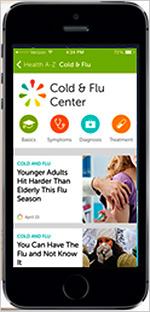
Health sites might seem like properties where people still most often turn to their desktop computer to get information. But the health and wellness category has hardly been immune to the broader
transition to mobile devices.
A recent Millennial Media study on cross-platform consumer habits indicated that people now split their time about evenly between the PC and mobile alternatives. (On
the mobile side, about 45% of time is spent on smartphones and 5% on tablets.) That's more than other categories like automotive and travel, where the bulk of time is still devoted to the desktop
computer.
The mobile migration in the health category was underscored in the first-quarter results reported Monday by Everyday Health. The digital health company that went public last month
has seen its apps downloaded 15 million times, with 62% of visits to its properties coming from mobile devices.
Similarly, rival health site WebMD said during its first-quarter earnings call a
couple of weeks ago that traffic growth is being driven by increased use of its mobile offerings. At the same time, the company noted that the trend has led to a decline in its desktop Web traffic, as
“users continue to rely on the larger screen size of the PC for many of their activities.”
Interestingly, when it comes to page views, WebMD combines PC and tablet numbers into a
single figure because the two formats provide a similar user experience. In that regard, page views were up 7% in the quarter, but offset by a 2% drop in U.S. PC-based views.
Monetizing the
increase in mobile traffic is another matter. WebMD CEO David Schlanger said the companies continues to see growing advertiser demand for its mobile but doesn’t expect an overnight change.
“I would think mobile is really going to be a steady build over the next several quarters and years as opposed to a dramatic inflection point,” he said.
Schlanger acknowledged that
one of the hurdles is for brands and sponsors to have mobile-optimized sites that they can send people to after clicking through. They also need to have an internal process where mobile creative units
can be reviewed by in-house regulatory staff. That's especially true for pharmaceutical companies, whose drug ads are regulated by the Federal Trade Commission.
Perhaps for that reason, pharma
marketers have been more advanced than other types of companies in their mobile advertising efforts, according to Schlanger.
For Everyday Health, which operates some 25 separate apps including
MedPage Today, What To Expect and The South Beach Diet, generating sales on the mobile side is especially important. In the first quarter, the company said mobile revenue increased 57%, and mobile now
accounts for a quarter of its total revenue.
Everyday Health also prices desktop and mobile advertising equally, according to a JPMorgan research note. Its overall revenue in the quarter was
up 23% to $37.5 million, including $32.7 million ad and sponsorship sales. It posted a net loss of $7.8 million, down from $9.2 million a year ago.